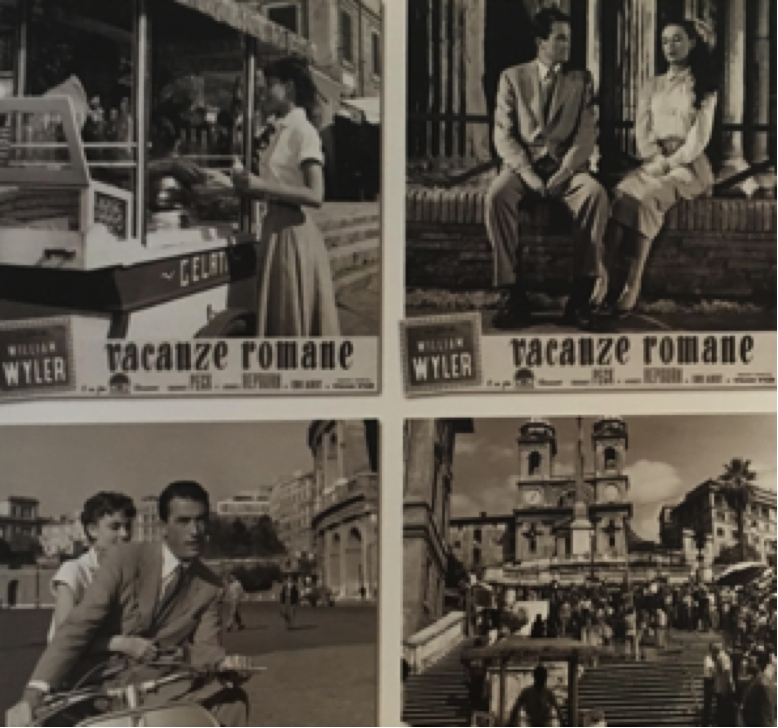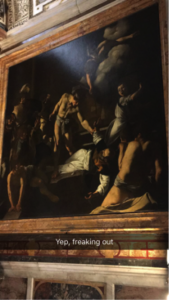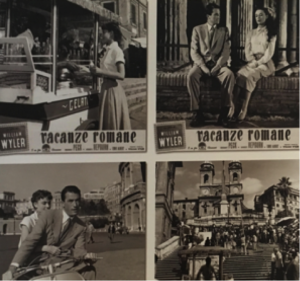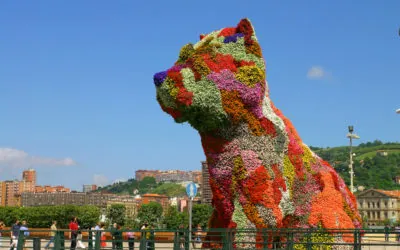This post comes to us from Christopher Moore. Christopher is currently studying Art History in Rome, Italy. He is studying abroad with API from Emmanual College.
During my second week in Rome, and feeling starved of an art-going experience, I decided to take a walk to the San Luigi dei Francesci. Located near the Pantheon and the Piazza Navona, it’s a church that, for an art history major like me, is an essential pilgrimage.
Why? Simply because of one man, one artist: Michelangelo Merisi da Caravaggio.
Caravaggio. It’s a name that, since his rediscovery in the mid-20th century, rings just as loud as Monet and Picasso’s do. And just as much as their lives have, Caravaggio’s has certainly caught the imagination of the public. Much of what we know about him comes to us through Rome’s crime archives. Violent and easily provoked, Caravaggio’s record shows a man who led a turbulent life. Whether he’s throwing a plate of artichokes at a waiter, pelting his landlady’s window with stones, escaping from a prison in Malta, and, yes, committing murder, he always seems ready with – and in need of – a sword and dagger.
But just as Caravaggio emerges from the darkness, so too does he vanish into it. Outside of his criminal record, the details of his life become less clear.
Walking into the San Luigi dei Francesci, it would seem that I had become enveloped by this darkness. Thinking his paintings would take pride of place in the church, I had imagined coming upon them instantly – a beam of light shining down upon them as it does on Saint Matthew in the painting by Caravaggio I was dying to see.
Soon enough, I found the paintings tucked away in a chapel, but in a state, I had not anticipated. The church had decided to illuminate the paintings only if one – or some other generous art goer – pays a fee. By inserting a 50 cent, 1 Euro or 2 Euro coin into a machine, one can see the works bathed in light for a few minutes.
And there I was with only 20 cent coins.
I suddenly became frantic. An older couple in front of me seemed to be slowly searching their pockets for coins, but after quickly realizing that I might age decades during this agonizing process, I decided to make a run to the nearest shop to get change.
I had a plan. I thought I would go to this touristy place beyond the Pantheon (okay, it wasn’t that near) that had postcards of scenes from the movie Roman Holiday, starring Gregory Peck and Audrey Hepburn. After purchasing them, I rushed down Rome’s cobblestone streets towards the direction of the San Luigi dei Francesci. Arriving at the church and walking towards the Contarelli Chapel where the paintings are located, little did I know that my attempt was in vain: other visitors were there admiring the paintings. And, yes, a generous member of their company had decided to pay the fee.
Confronted by Caravaggio’s immersive paintings, of which I think are comparable to watching a great film unfold before your eyes in all their power and directness, I realized I had become gripped by ‘Caravaggio mania’ – the art world’s term for the excitement surrounding Caravaggio since his rediscovery in the mid-20th century. Indeed, in all my haste, I didn’t realize until leaving the church that I had bought not just one, but three of the same postcards depicting scenes from Roman Holiday. No wonder why that shop attendant gave me a crazy look.
More than I care to admit, I’m obsessed with Caravaggio, no matter what I say to anyone else. (“No, I’m not THAT interested in the guy, there’s, um, like, so many other great artists besides Caravaggio!”). Unlike most other artists and their works, Caravaggio’s need little explanation and are explosive in their immediacy.
It’s because of art-going experiences like this that I chose to study in Rome. The city has been a global center for artists and patrons more than once during its long and illustrious history. For my “Baroque Rome and Its Monuments” class, I can experience the textbook come to life and see Caravaggio’s greatest masterpieces and visit Rome’s historic churches – all in person. Or, for my “Ancient Rome and Its Monuments” class, a lecture on the Aventine Hill with a view of the Circus Maximus – the site of chariot races in antiquity – is on offer too. The possibilities are almost endless. Rome’s encyclopedic showcase of periods in its history makes it a treasure trove for an art history student like me.







